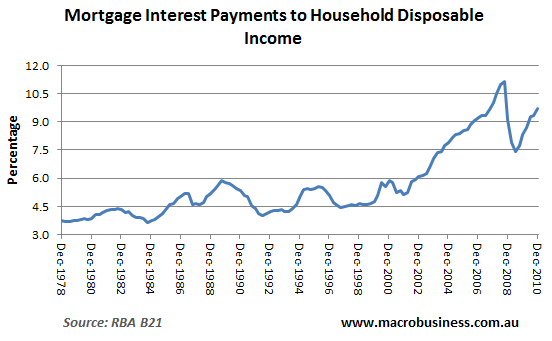
Houses and Holes today posted a nice summary of the recently released report from the Senate Inquiry into Competition within the Australian banking sector.
While there are some sensible recommendations in the report, including establishing a broad ranging inquiry into the Australian financial system, there are some absolute shockers aimed at increasing the availability of credit by pushing the risks of banking onto Australian taxpayers.
The following recommendations, in particular, struck a raw nerve with me [my emphasis]:
Recommendation 20
The Committee recommends that, to increase the competitiveness of smaller lenders, the Government immediately standardise the fee for all borrowers under the wholesale funding guarantee to a uniform rate of 70 basis points.
Recommendation 21
The Committee recommends that the financial claims scheme should be retained in its current form pending the outcome of a full inquiry into a deposit insurance scheme, possibly charging risk-related premia. The inquiry should also examine the issue of guaranteeing non-ADI products that are close substitutes for deposits, with a view to being better placed to provide such a guarantee as future need arises.
Recommendation 24
The Committee, having more confidence in the Australian Prudential Regulation Authority’s oversight than in the opinions of credit rating agencies, recommends that the Reserve Bank accept as eligible paper for repurchase agreements long term debt issued by any authorised deposit-taking institution rather than just those rated above A.
Recommendation 25
The Committee recommends that the Australian Office of Financial Management programme be expanded to include asset-backed securities based on assets other than home mortgages and to include securities rated AA or A (rather than just AAA) or issued by a financial intermediary supervised by the Australian Prudential Regulation Authority.
Recommendation 26
The Committee recommends that the Australian Office of Financial Management be given the discretion to purchase residential mortgage-backed securities issued by entities with a substantial bank shareholding where it judges this would promote a more competitive market.
Recommendation 29
The Committee recommends that Treasury develop a plan to introduce a support programme for RMBS similar to that operating in Canada in case a future deterioration in the securitisation market requires its introduction.
Over the past 20 years, competition in the Australian banking sector has increased markedly. In the early-1990s, non-bank lenders like Aussie home loans entered the mortgage market offering ‘innovative’ loan products on far easier terms than the banks. Included amongst these new loan products were low-doc loans (introduced in 1997) and ‘no-doc’ loans (introduced in 1999). More recently the non-banks were beginning to issue ‘non-conforming’ (sub-prime) loans just before the GFC intervened.
Faced with increased competition, Australia’s banks responded by lowering their deposit requirements from a minimum of 20% to 5%, and significantly increasing the amount that they would lend on a given level of income, with much of the funds borrowed from offshore.
The massive increase in the availability of credit sporn from this increased competition, combined with unresponsive housing supply, has resulted in the housing bubble that Australia experiences today.
However, the increased competition in the mortgage lending market has not improved housing affordability. Rather, the amount of total household disposable income required to service mortgage interest repayments has escalated over the past decade, as evident by the below chart.

Given that previous efforts at increasing competition in the mortgage market have failed to improve housing affordability, yet have reduced financial system stability (necessitating significant government intervention during the GFC and ongoing taxpayer support), what makes anyone think that the recommendations by the Senate Inquiry are desirable from an affordability or financial stability perspective?
As long as Australia’s land/housing supply is constrained, any extra housing (credit) demand arising from these proposals will be met with rising prices instead of new home construction.
What is particularly galling is that the Senate Committee has recommended that Australia introduce a support programme for RMBS similar to that operating in Canada.
As examined previously, the Canadian Mortgage Housing Corporation (CMHC) – the Government-owned guarantor of high loan-to-value-ratio mortgages – is a disaster waiting to happen. With default risk removed via the CMHC, Canada’s banks are able and willing to lend to people with little money, no savings history and questionable capacity to repay their loans.
In many ways, the CMHC is analogous to the United States government-sponsored Federal National Mortgage Association (Fannie Mae) and the Federal Home Mortgage Corporation (Freddie Mac), which provided insurance against default risk to a large proportion of risky low-deposit loans in the United States and whom required massive taxpayer bail-outs following the bursting of their housing bubble.
Moreover, CMHC is terribly under-capitalised and has the potential to expose Canadian taxpayers to significant losses should Canada’s housing market enter a protracted down-turn. As at 31 December 2009, the CMHC had only $9.3 billion CAD of shareholder capital but a whopping $473 billion CAD of outstanding insured loans – 29% of which had a loan-to-value ratio above 80%.
Should a housing correction occur, and significant defaults take place, there is very little capital available to absorb losses. Rather, like in the United States, Canadian taxpayers would be called upon to stump-up funds to bail-out the banks for their risky mortgage lending.
To add insult to injury, a leading Canadian think tank, the Fraser Institute, released a study in March 2010 highlighting the risks to taxpayers from the CMHC-insured system and suggested a privatised mortgage market structure similar to the one Australia uses. This study also confirmed that the taxpayer risk from a housing collapse is greater in Canada than elsewhere:
…the Canadian government is heavily exposed in the mortgage market because 43 per cent of all residential mortgages (including all loan-to-value mortgages over 80 per cent) are backed by the government through the federally owned Canada Mortgage and Housing Corporation (CMHC). The report recommends that the federal government follow Australia’s example by opening Canada’s mortgage insurance market to full competition including the privatization of the CMHC… The report points out that the Canadian model has the majority of risk concentrated with the Government of Canada, and therefore the taxpayer liability is much greater in Canada than in Australia…
In the wake of the recent financial crisis, American taxpayers are facing an enormous future liability to pay for the government bailout of the financial industry. Canadian taxpayers could face a similar liability because our government is so heavily involved in the mortgage insurance market through the CMHC…
In order to lessen the taxpayer exposure and reduce the likelihood of a Canadian mortgage crisis, the government should emulate Australia and allow the private sector to take total responsibility for insuring and securitizing Canadian residential mortgages.”
So while the Senate Committee has misguidedly recommended that Australia emulate Canada’s mortgage market, Canada is examining ways to become more like Australia’s.
Reflating the housing ponzi:
It is clear from where I sit that the Government’s focus on banking competition is a distraction from the real issue at hand – that Australia’s housing market has become highly unaffordable due to: easy credit funded, to a large extent, from offshore; investor speculation; and supply-side constraints. And now that house prices are correcting, thanks mainly to households reaching ‘peak debt’ as well as the banks finding it increasingly difficult to expand credit by borrowing offshore, the Government is once again looking to intervene in the market to reflate the credit/housing bubble and delay the day of reckoning.
What you, the reader, needs to ask yourself is whether this is how you want our banking system to operate: borrowing large sums from foreigners and channelling lending towards housing in place of productive enterprises, with the taxpayers picking up the tab if things go wrong? Is such an approach to banking in our national interest?
It’s a shame that our political leaders and mainstream commentators are not asking these important questions.
Cheers Leith

